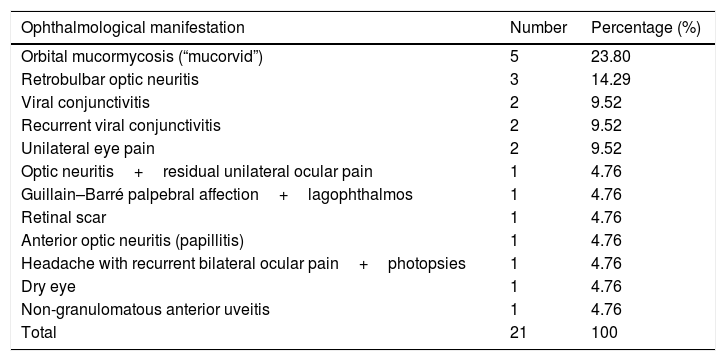Although the ophthalmic manifestations appear to be associated with the coronavirus disease 2019 (COVID-19), there is not enough evidence. Hence, the aim of this study was to determine the various types and frequency of ophthalmic manifestations in patients recovered from SARS-CoV-2 infection in Mexico.
Material and methodsThis retrospective, observational and descriptive study included all patients recovered from SARS-CoV-2 infection attending the tertiary level hospital of Mexican Social Security Institute (IMSS) from June 2020 to June 2022. During the hospital admission of patients, the demographic data such age, name, gender was recorded. Ophthalmologic examination was performed under torchlight by an ophthalmologist in the Department of Ophthalmology from IMSS. Data was compiled and statistically analyzed using Fisher’s exact test and Spearman correlation.
ResultsA total of 3081 SARS-CoV-2-positive patients were recorded, of which 318 (10.32%) met the inclusion criteria. Of them, 21 (6.60%) had ophthalmic manifestations and the female-to-male ratio was 1.6:1. The mean age (±SD) was 47.95±15.27 years and the median (interquartile range) time from the diagnosis of COVID-19, as defined by positive SARS-CoV-2 RT-PCR testing, to detection of the ophthalmic manifestation was 31 (142) days. The most common ocular manifestation was orbital mucormycosis (23.80%). Interestingly, the presence of ophthalmic manifestations was not associated with severe COVID-19 (p=0.665).
ConclusionsThe ophthalmic manifestations are infrequent in patients recovered from severe COVID-19. Nevertheless, further large sample studies are needed to confirm these findings.
Aunque las manifestaciones oftálmicas parecen estar asociadas a la enfermedad por coronavirus 2019 (COVID-19), no hay suficiente evidencia. Por ello, el objetivo de este estudio fue determinar los distintos tipos y la frecuencia de las manifestaciones oftálmicas en pacientes recuperados de la infección con SARS-CoV-2 en México.
Material y métodosEste estudio retrospectivo, observacional y descriptivo incluyó a los pacientes infectados con SARS-CoV-2 de junio de 2020 a junio de 2022. El examen oftalmológico fue realizado bajo luz de linterna por un oftalmólogo del Departamento de Oftalmología. Los datos fueron analizados estadísticamente mediante la prueba exacta de Fisher y la correlación de Spearman.
ResultadosSe registraron un total de 3.081 pacientes positivos de SARS-CoV-2, de los cuales 318 (10,32%) cumplían los criterios de inclusión. De ellos, 21 (6,60%) tenían manifestaciones oftálmicas y la proporción entre mujeres y hombres era de 1,6:1. La edad media (±DE) fue 47,95±15,27 años y la mediana (rango intercuartil) del tiempo transcurrido desde el diagnóstico de COVID-19, definido por la prueba RT-PCR del SARS-CoV-2 positiva, hasta la detección de la manifestación oftálmica fue de 31 (142) días. La manifestación ocular más común fue la mucormicosis orbital (23,80%). Interesantemente, la presencia de manifestaciones oftálmicas no fue asociada con COVID-19 grave (p=0,665).
ConclusionesLas manifestaciones oftálmicas son infrecuentes en los pacientes recuperados de COVID-19 grave. No obstante, se necesitan más estudios con una muestra de mayor tamaño para confirmar estos hallazgos.









